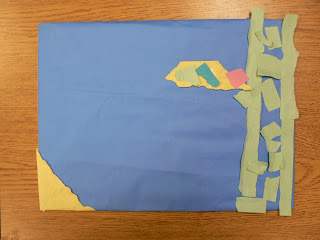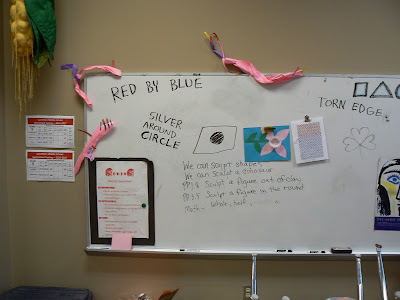March 21st, 22nd, and 23rd. The week her fifth and sixth grade groups began doing their first collage my wife asked me to come into her art room and assist. As the week progressed Mrs. Marxhausen shaped up the task. The collage needed to be FLAT and made with PAPER. Textures and other materials would come at another time. No glue gun or tape. Students used glue from the bottle. She was sick one day and got a substitute teacher to manage the students. She gave me instructions for the students to follow. In a day she was back in her room.
It was different to stand around, walk by table groups, and watch their work develop. But mostly stand back.
There was plenty of materials. Magazines, newspapers, colored paper rolls, and cut paper strips.
A few personal reflections of my own.
Nervousness. Not knowing what it might look like. No steps to follow. I could only guess what he was thinking. A student snipped little pieces of newspaper in a pile, above. But it was hard for him to settle and focus. I showed him how to move the larger shapes around and then I moved it back the way he had it. He seemed okay with it. But where I am coming from and what he was experiencing were light years apart. He was just starting the journey. I've been through several. The following week when the teacher gave him back his piece he threw it in the trash can. He didn't like it one bit. I pulled it out later. I liked the balance in it.
As a working artist, I could identify with the chaos and uncertainty this medium presented.
All eight classes produced a wide variety. Each solving it their way. I believe with all the materials, each shape, selecting, pasting, getting the slow glue bottle to work, all of it becomes your experience. Finding out what works for you and what does not. Yes!! Double click to enlarge.
Paper strips were popular. Cut with scissors.
One student had scissor-cut three strips of newspaper, glued down as diagonals. I noticed as I walked by his table that THAT was as far as he could go. It was quite easy to "get stuck." Collage can be that way. No frame of reference. Each dealt with the dilemma. Some spent more time chatting than experimenting. Some fiddled around.
At the same table another student had carefully scissor-cut a pile of red squares, a pile of white squares, and a pile of blue squares. Then he too got stuck. I happened to see the next thing: the student held all the squares in his hands above the board and let them fall down, a cascade all over the board. He looked over his shoulder at me and grinned. I was so proud of him. His idea. His risk. His trying something out. The next time I passed by he had rearranged all of it so there was a horizontal row of red squares overlapping each other across the top. A mid-row of white squares doing the same. And at the bottom, a row of blue squares lapped over each other. Moving your items around the page, and then moving it to another place, well, that takes time to do.
The student with the diagonal stripes above, he DID do MORE to his piece. Added scissor-cut squares and some hand torn shapes. He might have gotten that idea from his neighbor. Hurray!!
Hand torn shapes have their own character.
As I walked around the room some students asked me: "how am I doing?" I offered nothing. They were art makers, navigating unknown territory, learning tons one shape at a time. Their own effort.
Some students built up off the paper, 3D structures. It was not what Mrs. Marxhausen had asked for. Some students resorted to using marker and drawing. Paper shapes - flatness - color = these were a struggle.
On Wednesday I made my own collage using one color shapes onto the white board. Students followed it. Then, the art teacher made another rule: cover over all the white of the board. On Thursday I made another sample collage that met the boundaries set by the teacher.
1) Cover the whole board with one background color.
2) Glue smaller hand-torn shapes on top.
1) Cover the whole board with one background color.
2) Glue smaller hand-torn shapes on top.
Untitled. 14 by 15 inches. Flat paper on tagboard. Karl Marxhausen. Details, next.
The Thursday classes of fifth grade and sixth grade did works that mirrored my sample. A solid background. Hand-torn shapes.
For many, figuring out how to get paper big enough to cover the board TOOK UP MUCH of the 50 minute class period. Some traced the board on top of the paper, then cut that shape out, and glued it down. Some hand tore a shape larger than the board and glued that down. Some wrapped the paper around all four edges of the board. Some covered the back side as well. Lots of figuring went into THAT.
Interesting. One large torn shape. Strips to create borders. And delicate torn strips along bottom border edge. Done by a student. Bravo!!
Hand torn. Shapes that mirrored negative spaces. Nice!!
Add textures following week.


























































